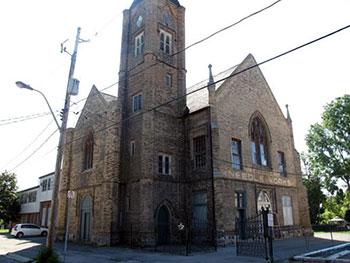Former Paris Town Hall National Historic Site

© County of Brant Public Library
The Former Paris Town was designated a national historic site in 2020.
Commemorative plaque: No plaque installedFootnote 1
Former Paris Town Hall, Paris, Ontario
Built in 1854, according to the plans of architect John Maxwell, this former town hall is a rare Canadian example of a civic building in the Gothic Revival-style. It is distinguished by the presence of medieval architectural details, including the magnificent wooden structure of the large hall on its second floor. It served as a combined town hall and market, similar to other buildings of this type built in Canada during the second half of the 19th century, which were inspired by British examples from the late 18th and early 19th centuries. It remains a monument to civic pride, constructed during a period of ambitious growth, when the small community of Paris emerged as an industrial town.
Now known as the Bawcutt Centre, the former Paris Town Hall is located at 13 Burwell Street, in what was once considered the centre of the small town of Paris, Ontario. This building's English Medieval Gothic Revival style, often seen in churches, was an unusual choice for a civic building of this type in the 19th century, when classicism prevailed. This two-and-a-half-storey brick building has a tower, which originally housed a bell, angled buttresses, which once had small turrets, and a combination of Gothic Revival-style pointed windows and Tudor-style rectangular windows.
Like its exterior, the building's interior has a number of original characteristics. On the second floor there is a room with vaulted ceilings and arched doorways, which is the building's centrepiece. The ceiling has exposed wooden beams, and six very well preserved Gothic trusses. Previously, the ground floor was home to a covered market at one end, and a council room, magistrate, and treasurer offices at the other. The basement was used as a “lower market” and had space for a small prison with two cells, which are still there.
For 50 years, the building was used as a town hall and market, with a meeting room on the second floor, which was used for events, such as plays, opera, concerts, conferences, and film projections. After the Paris municipal council left the building in 1904, it was used for various other purposes, including as a needle manufacturing plant, a private residence, retail headquarters for Mary Maxim's craft supplies, and an auction house.
In 2016, the Corporation of the County of Brant purchased the building from a private owner, with financial support from Linda Schuyler. The building was named the Bawcutt Centre in honour of Schuyler's parents, Jack and Joyce Bawcutt. The Corporation of the County of Brant plans to restore the building, so that it might be used as a community centre dedicated to theatre and performance.
Backgrounder last update: 2021-03-29
Description of historic place
The Former Paris Town Hall National Historic Site of Canada is a two-and-a-half-storey rectangular building covered in brick with stone inserts. It features a side tower, which originally housed a bell, angled buttresses, which once had small turrets, and a combination of Gothic-Revival-style pointed windows and Tudor-style rectangular windows. It stands on Burwell Street in the southeastern part of the small Ontario town of Paris in a predominantly residential area that was once considered the centre of the small Ontario town. The designation refers to the building as defined by its footprint on its lot at the time of designation, excluding the two later additions.
Heritage value
The Former Paris Town Hall was designated a National Historic Site of Canada in 2020. It is recognized because:
- built in 1854, according to the plans of architect John Maxwell, this former town hall is a rare Canadian example of a civic building in the Gothic Revival-style. It is distinguished by the presence of medieval architectural details, including the magnificent wooden structure of the large hall on its second floor;
- it served as a combined town hall and market, similar to other buildings of this type built in Canada during the second half of the 19th century, which were inspired by British examples from the late 18th and early 19th centuries;
- it remains a monument to civic pride, constructed during a period of ambitious growth, when the small community of Paris emerged as an industrial town.
Completed in 1854, Paris Town Hall was designed by Scottish architect John Maxwell. The English Medieval Gothic Revival style of the building, often seen in churches, was an unusual choice for a civic building of this type, when, in the 19th century, the prevailing tradition was classical.
Like its exterior, the building’s interior has a number of original features. The room on the second floor, with its vaulted ceilings and arched doorways, is the building’s crown jewel. The ceiling has exposed wooden beams and six magnificent and very well preserved Gothic trusses. When it was first built, the ground floor was home to a covered market at one end and a council room and magistrate and treasurer offices at the other. The basement was used as a “lower market” and also housed cells for two prisoners; these are still extant.
For its first 50 years, this building served as a combined town hall and market, then it was used for various other purposes including a First World War shell factory, a needle manufacturing plant, a retail craft store, a private residence, and an auction house.
Source: Historic Sites and Monuments Board of Canada, Minutes, December 2019.
The National Program of Historical Commemoration relies on the participation of Canadians in the identification of places, events and persons of national historic significance. Any member of the public can nominate a topic for consideration by the Historic Sites and Monuments Board of Canada.
- Date modified :